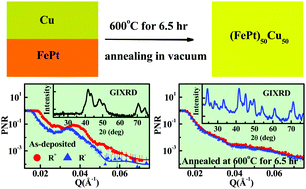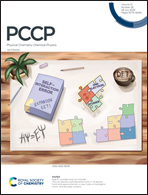Evolution of structural and magnetic properties of FePtCu alloy films on annealing of FePt/Cu multilayers
Abstract
Thin films of ternary (FePt)100−xCux alloys were obtained by annealing of FePt (100 Å)/Cu (d Å) multilayers with d = 50 and 100 Å deposited by sputtering at room temperature on Si substrates. The evolution of structural and magnetic properties of these multilayers induced by isochronal and isothermal annealing in a vacuum has been studied using depth dependent characterization techniques. Isochronal annealing for 0.5 h at different temperatures (300 to 600 °C) showed very low interdiffusion at the interfaces with no signature of alloy phase formation. However, isothermal annealing of multilayers at 600 °C for longer times (1.5–6.5 h) showed significantly large interdiffusion accompanied by the formation of polycrystalline ternary alloy and iron silicide phases. The iron silicide formed at the substrate–film interface assists the growth of the L10 ordered ternary alloy phase, which showed different stoichiometry for different multilayers. The L10 phase formed with higher Cu content showed drastically different magnetic properties with a reduction in saturation magnetization and an increase in coercivity (∼6 kOe) at room temperature. The iron silicide formed on high temperature annealing showed ferromagnetic nature with a magnetization of ∼140 emu cm−3 at room temperature.



 Please wait while we load your content...
Please wait while we load your content...